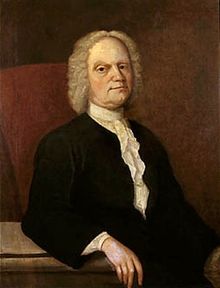Gustavus Hesselius
| Gustavus Hesselius | |
|---|---|

Self portrait, ca 1740
|
|
| Born |
Gustaf Hesselius 1682 Folkärna, Dalarna, Sweden |
| Died | May 25, 1755 Philadelphia, United States |
| Nationality |
|
| Known for | Painting |
Gustavus Hesselius (1682 – May 25, 1755) was a Swedish born painter who emigrated to the New World in 1711. He was the father of painter John Hesselius and cousin of the religious leader Emanuel Swedenborg.
Hesselius left his home country of Sweden for Wilmington, Delaware in 1711. There he lived until 1717 when he moved to Philadelphia, Pennsylvania, where he lived until 1721. In 1721, he moved to Prince George's County, Maryland and became a portrait painter, though he had been trained in Sweden. That same year, he received the first recorded public art commission in the American colonies; he painted The Last Supper. He also painted a Crucifixion. Some time around 1735, Hesselius returned to Philadelphia where he spent the rest of his life and traveling. He was listed as a member of the Gloria Dei (Old Swedes') Church in Philadelphia.
He also worked as an organ builder, having built an organ for the Moravian Church in Bethlehem, Pennsylvania in 1746. From about this time on, he focused on building organs, referring painting commissions to his son John.
J. Hall Pleasants has said that Hesselius became "America's earliest portrait painter of note." In 1994 he was named to the Prince George's County Hall of Fame.
While most of his portraits adhere to the formality typical for American portrait painting of his time, according to Michael J. Lewis, his portrait of Lappawinsoe, chief of the Lenape, was among the first to foreshadow "the sympathetic and unaffected realism" that would later develop in American portraiture. The painter was able to ignore the rigid conventions of colonial society because Lappawinsoe was a member of a First Nation.
...
Wikipedia
